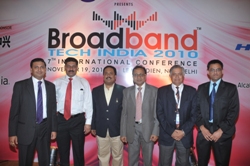 At Broadband Tech India 2010 conference organized by Bharat Exhibitions held today at Le Meridien, Experts differed on whether opticfibre cable television or broadband wireless or 3G would enable a countrywide broadband target of 100 to 240 million subscribers how best would be achieved.
At Broadband Tech India 2010 conference organized by Bharat Exhibitions held today at Le Meridien, Experts differed on whether opticfibre cable television or broadband wireless or 3G would enable a countrywide broadband target of 100 to 240 million subscribers how best would be achieved.
After information and education, the next step should be Broadband as a legal right. But before that could be mandated in India as in some countries like Finland, the experts have to settle which way broadband and at what level of carrier it should be delivered. The years 2010-2020 have been declared as Decade of Broadband.
In a wide area of low literacy and even lower computer literacy, the most effective solution lies in two-way cable TV, claimed Mr. Vijay Yadav, Managing Director, South Asia, UTStarcom India. There was already adequate fibre buried for connectivity with 30 million fibre loops. “ Our people even in rural areas are intelligent handset listeners” Mr. Yadav pointed out but using the PC or laptop for broadband access was to ignore the difficulty of taking computer literacy first to the masses. The basic need is to give information to the masses.
“Imagine the problem for a rural resident to use the keypad to find out whether there is the food grain in the local ration shop. On the other hand how easy it would be to convey to him the information over his TV where millions of homes today can switch channels easily”, Mr. Yadav said giving the keynote speech at the Broadband Tech India conference organized by Bharat Exhibition. With Internet Protocol TV being available now, the technology is not the problem. He suggested tying up with cable operators who are already reaching over 100 million homes across the wide expansion of the country. That would also reduce infrastructure costs for countrywide broadband access.
But many other telecom experts present at the conference did not agree.
Mr. Puneet Garg Vice-president –Technical, Bharti Airtel claimed that wireless broadband access (BWA) and 3G would be the driver to provide access for the rural masses to this facility. BWA and 3G would be complementary technologies for broadband access. The emphasis should not be on high speed spectrum but how quickly we can provide the access, whether 256 kHz or 2 MHz. “Expose people to Internet and then decide at what speed should it be done” was Mr. Garg’s solution. However, he also drew attention to the narrow level of spectrum provided for each operator for the wireless broadband and how that was pushing up costs as higher investments were needed to widen the reach with so little spectrum.
Suggesting an alternate route to reach out to rural areas, Mr. Bijender S. Yadav network planning head Sistema-Shyam Teleservices called for opening up 900MHz and lower speed spectrum for rural penetration. As lower the speed the wider is the area of penetration the 2.3GHz spectrum now given for 3G would raise costs for rural operations.
Mr. T. R, Dua Deputy Director-General Cellular Operators Association of India also endorsed this approach and called for opening up 700 MHz spectrum for rural penetration. Pointing out that 30 per cent of the telcos revenue now went to Government and large corpus of the USO fund was lying unused. This fund could be used to support broadband infrastructure . The COAI executive wanted a National Infrastructure Policy in the context of differing levies and rules for infrastructure levies by different states and a Broadband Fund to be created as well as fast track clearances to enable fast roll out of broadband services across the country. More and relevant local content and low cost devices would speed up broadband penetration.
In the context of speeding up broadband and Internet usage,Mr. Rajesh Chharia President, Internet Service Providers Association of India decried the step motherly treatment being meted out to Internet Service Providers (ISPs) that was constraining Internet spread. This was in sharp contrast to Government helping mobile telecom spread with reduced licence fees and other facilities and telcos themselves were ignoring the viability of ISPs in sharing the subscriber revenue, Mr. Chharia charged.
Countrywide broadband penetration would help create a knowledge based economy and society and add 20 million jobs, Mr. Shashi Dharan , Managing Director of Bharat Exhibitions pointed out.
